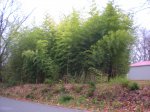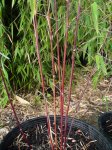Although not a tree but actually more of a grass:
I heard -correct me if I'm wrong, that when a bamboo species flowers, every 40 years or so, all the plants of the same species flower at the same time everywhere in the world, and after flowering, the upper plant dies.
Myth or reality?...
This is true, though the number varies between different bamboo species. The term is gregarious flowering, and it is a world wide phenomena.
There are many hundreds of species of true bamboos, both tropical and temperate species. About 2 thirds of the species flower gregariously, but there are a number of genera of true bamboo that do not follow the gregarious pattern.
Fargesia, a genus of bamboo often eaten by pandas. There are some 15 to 25 species of Fargesia, each species has its own number of years between gregarious flowering, usually 101, 103, 107, 109, or 113 years. Why these numbers? They are prime numbers greater than 3 times the average life span of their principal predator, the panda. Young Fargesia seedlings and Fargesia seed are nutritious and relished by Pandas. By having the gregarious interval greater than 3 times the average life span of its principal predator, the bamboo avoids the possibility of the panda synchronizing its population boom and bust cycles to take advantage of the bamboo flowering. For example when Fargesia murielae flowers, an area as large as New Hampshire or Vermont becomes covered with blooming bamboo and tons of nutritious seed per acre. So making flowering a rare event defeats a predator's attempts to have its population boom just prior, and in time to take advantage of the abundant seed. Neat trick - eh?
Divisions of plants and seedlings from a gregarious flowering species tend to stay on the same schedule, no matter where in the world the plants is, it will stay on the same schedule. Since flowers are the main botanically significant trait with which to identify a species of grass, botanical gardens all over the world often have to wait a century to verify the identity of bamboos in their collections. The Royal Botanic Garden at Kew, near London UK, has an extensive collection of temperate bamboo species. Many have provisional names, and are waiting for the year they start to flower in order to verify and complete the botanical description process. I visited this collection in 1988 when I was real into bamboo. I'm ''not so much'' in love with bamboo, but still have 5 species, with 3 cultivars of one of the 5, all fully winter hardy, planted outdoors in my garden, north of Chicago. Some temperate bamboos are quite hardy.
Reality is the gregarious flowering usually lasts 2 to 5 years, during this time, instead of producing new culms (canes with leaves) the new culms only have flower heads, with very minimal leaves, mostly just sheath leaves. These are produced using the stored energy in the rhizome. New leaves are insufficient to replace this energy, within a couple years the rhizome will be exhausted. The seed is relatively large, like a wheat or rice seed, and the yield from bamboo compares to weight per acre as these grain crops, it is lower than wheat and rice per acre, but in the same order of magnitude, which means this seed is a huge metabolic cost to the plant. When the rhizomes are exhausted, they die. Occasionally one or two pieces of a clone in flower will survive, but it is quite rare. So in the Panda's native range, suddenly areas as large as a smaller New England State will be devoid of mature bamboo to eat. This life plan really screws with the Panda. They have to move, often fairly large distances when flowering finishes.
Lastly some of the gregarious species have populations that are tied to a different year. For example there are several populations of one of the Phyllostachys, both gregariously flower at roughly 113 year interval, but one flowered in the 1990's and the second flowered in 2008. Both are thought to be the same species, but they are curiously not synchronized. Collection data is not clear, whether they came from the same region or widely separated regions.
Some of the tropical bamboos are on much shorter schedules, 37, 41 and 47 year intervals are pretty common. All prime number intervals. The article did not identify the principal bamboo predators. National Geographic had an article about how in a region of India, the flowering every 47 years of a certain species bamboo caused wars the year after the flowering finished. The bamboo was a significant species of the local forest and forest edge. When flowering the rat population explodes, feeding on bamboo seed. When the flowering finishes, by the 3rd year the rat population is huge, the bamboo seed is gone, and the rats flood into the local villages eating all the stored rice, grain and any other stored food they can get to. The resulting food shortages lead to political strife, and prior to paved roads and easy transportation of famine relief food supplies the result would be war between the neighboring groups. The documentation of these wars went back nearly a millenia.
So that is a little I know about a really cool group of plants, the bamboo. I love the look of a well groomed grove of bamboo. A poorly groomed grove looks awful. Lately my plantings look like shit, bamboo is a high maintenance landscape plant. If you don't have time to groom the planting, at least twice a growing season, give the bamboo a pass.







